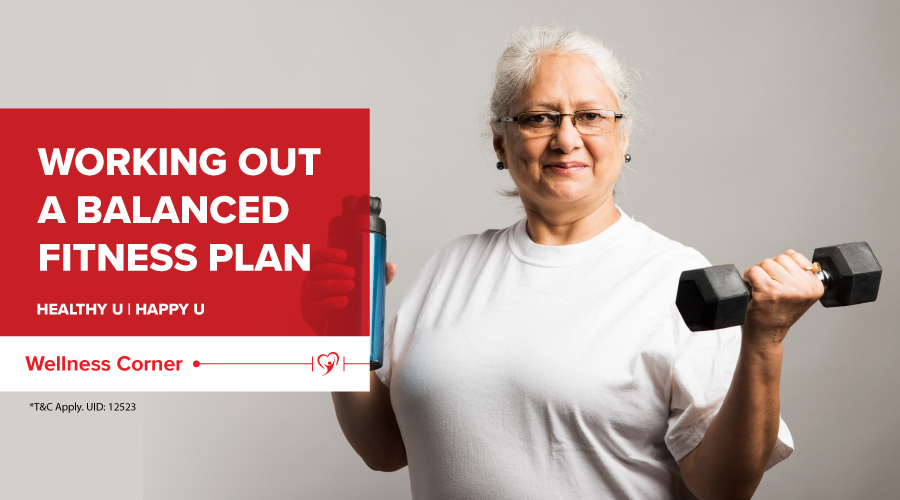

Exercise As You Age To Stay Fit
- Overview
- Importance
- Key Facts
- Benefits
- Balanced Exercise Plan
- Myths vs. Facts
- Exercise Safely
- Tips
- Conclusion
- FAQs
Overview
There is no specific age to maintain fitness; performing a physical activity is necessary for all age groups. When it comes to older adults, exercise can help them stay motivated, active, and free from all diseases and thereby help in the development of overall well-being. Most people perceive exercise as lifting weights in the gym or running for a longer duration on the treadmill; however, those are not the only way to stay fit. You can do cycling, swimming, dancing, yoga or just a brisk walk every morning to keep yourself fit as you age.
Importance of Exercise and Fitness
Exercising is necessary as you age to keep your joints healthy, maintain proper weight and reduce the risk of various chronic diseases. Inactivity is associated with alterations in body composition, resulting in an increase in body fat percentage and a decline in lean body mass.
According to a study published in the National Institute of Health, exercise training in older people has been associated with health benefits such as decreased cardiovascular mortality.
Key Facts to Know
- Keeping active helps you stay physically and mentally strong.
- Aim for about 30 minutes of moderate-intensity physical activity on most days, but any amount of activity is beneficial — even just a few minutes.
- Strength and weight-bearing activities can increase bone density, helping to prevent osteoporosis.
- Consider exercising with a friend, and choose activities you enjoy, to help you stay motivated.
Benefits of Exercise for Older Adults
It is advisable for older adults to keep their bodies mobile as it helps in the smooth functioning of various bodily systems. There are numerous health benefits for exercising during the ageing process, including:

- Improved fitness: Exercising regularly in older age is a crucial part of the ageing process, especially as our bodies gradually become frailer.
- Promotes a healthy weight range: Elderly people tend to become more sedentary as they age which unfortunately leads to weight gain, including an increase in fat mass and decrease in muscle mass. Therefore, regular exercise in elderly is important for promoting a healthy weight range.
- Increased happiness: When you exercise, you produce hormones that have positive effects on our nervous system and brain. One of these hormones is endorphins which is responsible for increasing our happiness. Performing routine physical activity is a great way to boost our mood, especially as we get older.
- It helps with sleep: Sleeping issues and lower sleep levels are more common among older people which can give rise to other health issues, including mental health concerns like anxiety and depression. Routine physical activity can help one sleep better.
- Helps with cognitive function: Regular exercising reduces chances of developing dementia and other cognitive problems that may arise with the ageing process. This is because routine physical activity improves blood flow and oxygen in our body thereby promoting cell growth and regeneration as well as boosting our mood, memory, and mindfulness.
- It helps improve bone density: Doing weight bearing exercises help increase bone mass and strength. Regular exercising can help increase bone density when you’re younger and reduce chances of developing osteoporosis, a disease that weaken bone and increases the risk of breaks as you age.
Build a Balanced Exercise Plan
A balanced exercise plan for an older adult should be a mix of aerobic and anaerobic exercises. Older adults who haven’t trained much throughout their lives should avoid exercises that shoot up the heart rate to a very high level. Older people should train in the range of 65% to 75% of the target heart rate (THR). Four main types of exercises that older people should incorporate in their routine are:

- Balance: These exercises help maintain posture and stability level. Older adults can perform yoga asanas to improve their balance and posture.

- Cardio: In this form of exercise, larger muscle groups are used in rhythmic motions over a period of time. It gets your heart pumping and may even leave you feeling a little short of breath. Cardio workouts include stair climbing, walking, swimming, cycling, hiking, and dancing which help improve endurance and heart health.

- Strength & Power Training: Bodyweight strength training like air squats, lunges, push-ups, pull-ups, etc., can helps prevent loss of bone mass, build muscle, and improves balance. Strength training can also be performed with dumbbells and elastic bands. On the other hand, power training, which are exercises done at a faster pace can improve your power and reaction time. Building strength and power will help you stay independent and make daily activities such as opening a jar and lifting objects easier.

- Flexibility: These exercises help the body stay limber and increases the range of movement for ordinary physical activities, such as looking behind while driving, tying shoe lace, shampooing your hair, etc. This can be done through stationary stretches or stretches that involve movement to keep your muscles and joints supple and less prone to injury.
If you have a medical condition or have been mostly inactive, see your doctor before starting any vigorous exercise program.
Myths Vs. Facts
1. Myth: Older people can’t go to the gym.
Fact: Gyms are not just for young people. Many older people enjoy working out at gyms or attending exercise classes, many of which are tailored for seniors.
2.Myth: Frail people can’t exercise.
Fact: Physical activity can actually help you become stronger and less frail. Most people can find enjoyable ways to safely stay active, even if they have health problems or are frail.
3.Myth: I’m too old to start exercising.
Fact: It’s never too late to become more active and enjoying the benefits of physical activity. Improving fitness and mobility, even at an older age, will boost your physical and mental health, and quality of life.
How to Start Exercising Safely
When you start physical training at old age, it is necessary to follow certain safety tips as follows:
- Medical Clearance: Before starting the exercise routine at an older age, get the doctor's necessary medical clearance, especially if you have a preexisting condition. Ask if there are any activities you should avoid.
- Consider Health Concerns: Speak with the fitness counselor/trainer before preparing the workout routine. They should know about your ongoing health problems. For example, people with diabetes may need to adjust the timing of medication and meal plans when setting an exercise schedule.
- Listen To Your Body: Stop exercising immediately and call your doctor if you feel dizzy or short of breath and develop chest pain. Always know your target heart rate (THR) before starting the exercise. It is not advisable for older people to train beyond 80% of THR. You can calculate your THR by subtracting your age from 222. E.g. Your age is 45, then your THR =220-45 = 175.
- Prevent Injury: Always warm-up before the exercise and cool down your body post-workout with relevant stretching. This can help minimize the chances of injury during physical training.
- Stick To An Exercise Schedule: Adhere to your workout schedule for at least three or four weeks so that it becomes a habit and force yourself to stick with it. This is much easier if you find activities you enjoy.
Tips to Stay Motivated
Numerous things can de-motivate you during your fitness journey. For example, you can suffer from illness, injury, etc., that can interrupt your routine and seem to set you back to square one. But there are various ways to stay motivated.
- Focus On Short-Term Goals: At older age, the primary focus of workout should be to reduce stress, improve health and increase activeness. Instead of focusing on one goal, that takes time, focus on multiple shorter goals, that motivate you.
- Reward Yourself: When you complete a workout, reach a new fitness goal, or show up on a day when you were tempted to ditch your activity plans, reward yourself with your favourite meal to stay motivated.
- Keep A Log: Use an app to track your progress; it will hold you accountable and be a valuable reminder of your accomplishments. You can also share your daily workout log from the app on social media and get good appreciations from your friends. This is another way to stay motivated during workout.
- Find Support: When you work out with your spouse or a friend or a family member, you can get high level of motivation since you encourage each other.
Conclusion
Exercise is an imperative part of anyone’s personal health, happiness and fitness, but especially so for the elderly to ward off some of the more unfortunate effects of the ageing process. No matter your age or physical condition, it’s never too late to start exercising. It doesn’t have to be strenuous as even a simple exercise form can help keep the body moving and endorphins flowing. It’s a great way to promote improved health later in life!
Frequently Asked Questions on Elderly Exercises & Fitness
1. How can exercise promote healthy ageing?
Regular exercise and physical activity can reduce the risk of developing diseases and disabilities that often occur with ageing. For example, balance exercises help prevent falls which is a significant cause of disability in older adults, while strength exercises can help build muscles and reduce the risk of osteoporosis.
2. What exercises slow ageing?
Constant aerobic exercise slows down the effects of ageing and ultimately reverses the effects. Aerobic exercises like swimming, cycling, jogging, etc., could create a drug that de-ages muscle stem cells.
3. Can exercise reverse sagging skin?
Building muscle mass through weight training exercises can help decrease the appearance of loose skin due to ageing. Bodyweight resistance training replaces the fat with muscle mass which can lessen the appearance of loose skin.
Source: HealthSurgeon, HealthDirect.gov, Time, Nia.Nih
Get a right Health Insurance today & protect your savings from unexpected medical expenses.
Staying fit and active as you age has its benefits and advantages. But don’t leave everything to chance. Health issues can lead to unplanned expenses draining your savings. To save yourself from all such troubles, check out our Senior Citizen Health insurance plans and live a carefree life.
Disclaimer: This blog provides general information and discussions about health and related subjects. The information and other content provided in this blog, website or in any linked materials are not intended and should not be considered, or used as a substitute for, medical advice, diagnosis or treatment. Kindly contact your Doctor before starting a new medicine or health regime.

/well-being-in-old-age_s.png)
/old-age_s.png)
/elderly-diseases_sd973bacc7e3d41b4ab609cf9364d5a8b.jpg)












 Car Insurance
Car Insurance  Bike/Two Wheeler Insurance
Bike/Two Wheeler Insurance  Health Insurance
Health Insurance  Pet Insurance
Pet Insurance  Travel Insurance
Travel Insurance  Home Insurance
Home Insurance  Cyber Insurance
Cyber Insurance  Third Party Vehicle Ins.
Third Party Vehicle Ins.  Tractor Insurance
Tractor Insurance  Goods Carrying Vehicle Ins.
Goods Carrying Vehicle Ins.  Passenger Carrying Vehicle Ins.
Passenger Carrying Vehicle Ins.  Compulsory Personal Accident Insurance
Compulsory Personal Accident Insurance  Travel Insurance
Travel Insurance  Rural
Rural  Critical illness Insurance
Critical illness Insurance 










